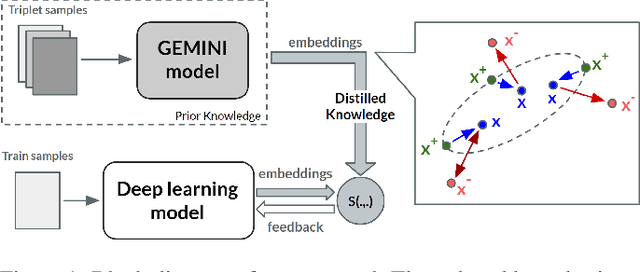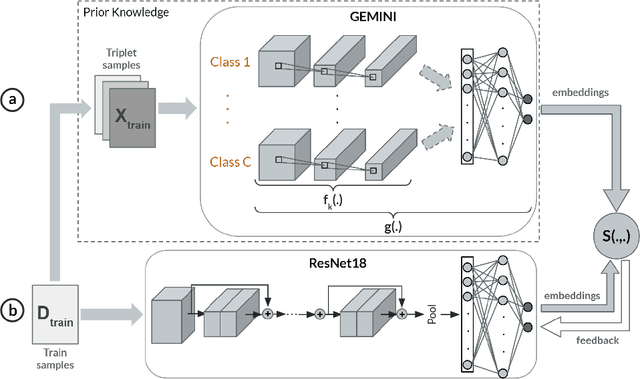Jorge Gonzalez-Zapata
A metric learning approach for endoscopic kidney stone identification
Jul 13, 2023Abstract:Several Deep Learning (DL) methods have recently been proposed for an automated identification of kidney stones during an ureteroscopy to enable rapid therapeutic decisions. Even if these DL approaches led to promising results, they are mainly appropriate for kidney stone types for which numerous labelled data are available. However, only few labelled images are available for some rare kidney stone types. This contribution exploits Deep Metric Learning (DML) methods i) to handle such classes with few samples, ii) to generalize well to out of distribution samples, and iii) to cope better with new classes which are added to the database. The proposed Guided Deep Metric Learning approach is based on a novel architecture which was designed to learn data representations in an improved way. The solution was inspired by Few-Shot Learning (FSL) and makes use of a teacher-student approach. The teacher model (GEMINI) generates a reduced hypothesis space based on prior knowledge from the labeled data, and is used it as a guide to a student model (i.e., ResNet50) through a Knowledge Distillation scheme. Extensive tests were first performed on two datasets separately used for the recognition, namely a set of images acquired for the surfaces of the kidney stone fragments, and a set of images of the fragment sections. The proposed DML-approach improved the identification accuracy by 10% and 12% in comparison to DL-methods and other DML-approaches, respectively. Moreover, model embeddings from the two dataset types were merged in an organized way through a multi-view scheme to simultaneously exploit the information of surface and section fragments. Test with the resulting mixed model improves the identification accuracy by at least 3% and up to 30% with respect to DL-models and shallow machine learning methods, respectively.
SuSana Distancia is all you need: Enforcing class separability in metric learning via two novel distance-based loss functions for few-shot image classification
May 18, 2023Abstract:Few-shot learning is a challenging area of research that aims to learn new concepts with only a few labeled samples of data. Recent works based on metric-learning approaches leverage the meta-learning approach, which is encompassed by episodic tasks that make use a support (training) and query set (test) with the objective of learning a similarity comparison metric between those sets. Due to the lack of data, the learning process of the embedding network becomes an important part of the few-shot task. Previous works have addressed this problem using metric learning approaches, but the properties of the underlying latent space and the separability of the difference classes on it was not entirely enforced. In this work, we propose two different loss functions which consider the importance of the embedding vectors by looking at the intra-class and inter-class distance between the few data. The first loss function is the Proto-Triplet Loss, which is based on the original triplet loss with the modifications needed to better work on few-shot scenarios. The second loss function, which we dub ICNN loss is based on an inter and intra class nearest neighbors score, which help us to assess the quality of embeddings obtained from the trained network. Our results, obtained from a extensive experimental setup show a significant improvement in accuracy in the miniImagenNet benchmark compared to other metric-based few-shot learning methods by a margin of 2%, demonstrating the capability of these loss functions to allow the network to generalize better to previously unseen classes. In our experiments, we demonstrate competitive generalization capabilities to other domains, such as the Caltech CUB, Dogs and Cars datasets compared with the state of the art.
Guided Deep Metric Learning
Jun 04, 2022



Abstract:Deep Metric Learning (DML) methods have been proven relevant for visual similarity learning. However, they sometimes lack generalization properties because they are trained often using an inappropriate sample selection strategy or due to the difficulty of the dataset caused by a distributional shift in the data. These represent a significant drawback when attempting to learn the underlying data manifold. Therefore, there is a pressing need to develop better ways of obtaining generalization and representation of the underlying manifold. In this paper, we propose a novel approach to DML that we call Guided Deep Metric Learning, a novel architecture oriented to learning more compact clusters, improving generalization under distributional shifts in DML. This novel architecture consists of two independent models: A multi-branch master model, inspired from a Few-Shot Learning (FSL) perspective, generates a reduced hypothesis space based on prior knowledge from labeled data, which guides or regularizes the decision boundary of a student model during training under an offline knowledge distillation scheme. Experiments have shown that the proposed method is capable of a better manifold generalization and representation to up to 40% improvement (Recall@1, CIFAR10), using guidelines suggested by Musgrave et al. to perform a more fair and realistic comparison, which is currently absent in the literature
 Add to Chrome
Add to Chrome Add to Firefox
Add to Firefox Add to Edge
Add to Edge